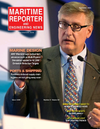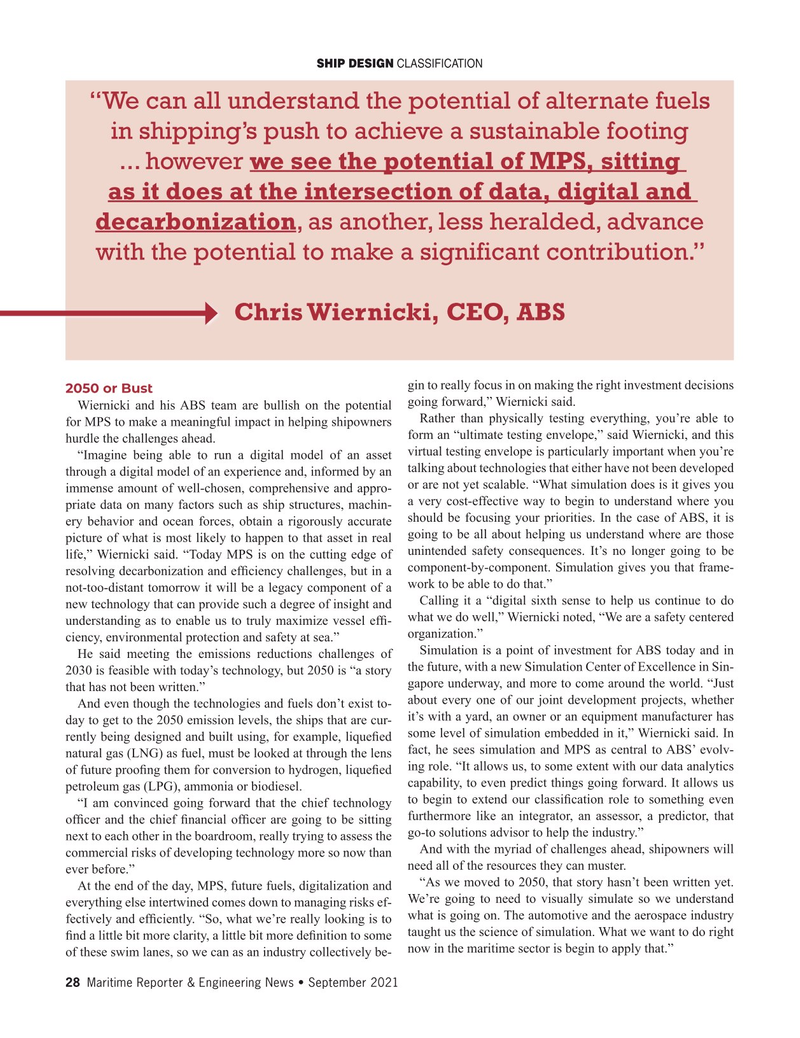
Page 28: of Maritime Reporter Magazine (September 2021)
The Marine Design Edition
Read this page in Pdf, Flash or Html5 edition of September 2021 Maritime Reporter Magazine
SHIP DESIGN CLASSIFICATION “We can all understand the potential of alternate fuels in shipping’s push to achieve a sustainable footing ... however we see the potential of MPS, sitting as it does at the intersection of data, digital and decarbonization, as another, less heralded, advance with the potential to make a significant contribution.”
Chris Wiernicki, CEO, ABS gin to really focus in on making the right investment decisions 2050 or Bust
Wiernicki and his ABS team are bullish on the potential going forward,” Wiernicki said.
Rather than physically testing everything, you’re able to for MPS to make a meaningful impact in helping shipowners form an “ultimate testing envelope,” said Wiernicki, and this hurdle the challenges ahead.
“Imagine being able to run a digital model of an asset virtual testing envelope is particularly important when you’re through a digital model of an experience and, informed by an talking about technologies that either have not been developed or are not yet scalable. “What simulation does is it gives you immense amount of well-chosen, comprehensive and appro- a very cost-effective way to begin to understand where you priate data on many factors such as ship structures, machin- ery behavior and ocean forces, obtain a rigorously accurate should be focusing your priorities. In the case of ABS, it is picture of what is most likely to happen to that asset in real going to be all about helping us understand where are those life,” Wiernicki said. “Today MPS is on the cutting edge of unintended safety consequences. It’s no longer going to be resolving decarbonization and ef? ciency challenges, but in a component-by-component. Simulation gives you that frame- not-too-distant tomorrow it will be a legacy component of a work to be able to do that.”
Calling it a “digital sixth sense to help us continue to do new technology that can provide such a degree of insight and what we do well,” Wiernicki noted, “We are a safety centered understanding as to enable us to truly maximize vessel ef? - organization.” ciency, environmental protection and safety at sea.”
Simulation is a point of investment for ABS today and in
He said meeting the emissions reductions challenges of 2030 is feasible with today’s technology, but 2050 is “a story the future, with a new Simulation Center of Excellence in Sin- gapore underway, and more to come around the world. “Just that has not been written.” about every one of our joint development projects, whether
And even though the technologies and fuels don’t exist to- it’s with a yard, an owner or an equipment manufacturer has day to get to the 2050 emission levels, the ships that are cur- rently being designed and built using, for example, lique? ed some level of simulation embedded in it,” Wiernicki said. In natural gas (LNG) as fuel, must be looked at through the lens fact, he sees simulation and MPS as central to ABS’ evolv- of future proo? ng them for conversion to hydrogen, lique? ed ing role. “It allows us, to some extent with our data analytics capability, to even predict things going forward. It allows us petroleum gas (LPG), ammonia or biodiesel.
“I am convinced going forward that the chief technology to begin to extend our classi? cation role to something even of? cer and the chief ? nancial of? cer are going to be sitting furthermore like an integrator, an assessor, a predictor, that go-to solutions advisor to help the industry.” next to each other in the boardroom, really trying to assess the
And with the myriad of challenges ahead, shipowners will commercial risks of developing technology more so now than need all of the resources they can muster.
ever before.” “As we moved to 2050, that story hasn’t been written yet.
At the end of the day, MPS, future fuels, digitalization and
We’re going to need to visually simulate so we understand everything else intertwined comes down to managing risks ef- fectively and ef? ciently. “So, what we’re really looking is to what is going on. The automotive and the aerospace industry taught us the science of simulation. What we want to do right ? nd a little bit more clarity, a little bit more de? nition to some now in the maritime sector is begin to apply that.” of these swim lanes, so we can as an industry collectively be- 28 Maritime Reporter & Engineering News • September 2021
MR #9 (18-33).indd 28 MR #9 (18-33).indd 28 9/7/2021 9:46:42 AM9/7/2021 9:46:42 AM

 27
27

 29
29
